Sandals come in a variety of sizes and styles, and our expert guide to women’s sandals and flip-flops explains everything you need to know to find a perfect pair for your needs.
Measuring Your Foot Size
Why Measuring Your Foot Size is Important
Sizing for sandals can vary across different brands and countries. Characteristics such as shape, style, and material can all affect the fit of your footwear. To ensure you’re getting the right fit, always measure your foot size and consult the footwear sizing guide from the brand you are considering.
How To Measure Your Foot Size Accurately
- Gather your materials. You will need 2 sheets of blank paper (large enough for your foot, plus a bit more), a pencil, tape, and a ruler.
- Tape the piece of paper to the floor. This will avoid it from moving around while you measure.
- Place your foot in the center of the paper. You can do this while kneeling on one leg with your other leg on the paper or standing with your leg slightly bent with your shin in front of your ankle.
- Trace the outline of your foot all the way around. Make sure to mark directly around your foot, with no gap between your pencil and the edges of your foot.
- Using the ruler to make straight lines, mark the length and the width of your foot. The length will be the measurement from your heel to your tallest toe, and the width will be the measurement of the widest part of your foot.
- Note your length and width measurements. Your foot length will determine the size you buy, and your foot width can help you determine a suitable shoe style.
- Repeat this process for your other foot. It’s not uncommon to have two different size feet. If this is the case, take the larger set of measurements.
- Compare your foot measurements with the size chart provided by the sandal manufacturer. Make sure to note your measurements in both metric and imperial to check against size charts in either unit of measurement.
Should you size up in sandals?
If you are in between sizes, we recommend sizing up. It’s better to have a little wiggle room than to be too small.
Finding the Right Fit
Understanding Your Foot Shape
What Is a Sport Bathing Suit?
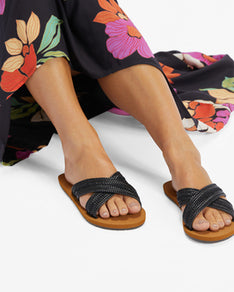
Foot width and toe shape are two different factors in understanding your foot shape and how it relates to footwear.
Foot width can be categorized as neutral, wide, or narrow. Compared to an average foot, a wide foot indicates a broader and sometimes thicker shape, whereas a narrow foot is more slender.
You use your foot measurements to understand which category you fall into. Always be sure you are buying the correct width shoe to get the best fit.
All feet are different – sometimes the second toe is longer than the big toe or sometimes toes have a bend in them. For this, we recommend slide sandals with loose straps or thong styles that won’t constrict your toes.
Understanding Your Arch Type
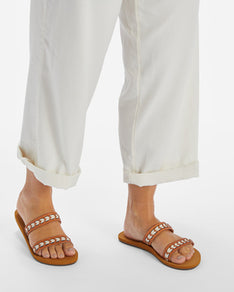
The arch of your foot is the space between the heel and the ball of your foot. For most people, it curves slightly upward to balance your body weight and impact. Some people have higher arches, and other people have none at all. In fact, your foot arch can change over time, and is impacted by factors like aging, pregnancy, and fluctuations in weight.
Determining your foot arch with the Wet Test:
- Gather your materials. If inside, you will need water, a flat floor, and a piece of paper to stand on. If outside, you will need water and a flat area of ground where you can leave a footprint (like a concrete sidewalk or driveway).
- Wet the bottom of your foot and stand firmly on the surface. Evenly balance your weight front and back, and side to side to get an accurate print.
-
Examine the footprint:
- High arches: You will see the heel and ball of the foot, and either a thin line on the baby-toe side of the foot or nothing at all.
- Low arches: Often called ‘flat foot’, you will see the full shape of the foot with very little curve.
- Normal arches: The middle portion or arch of your footprint is just about halfway filled in with a noticeable curve along the arch.
What does this have to do with sandal choice? People with high arches absorb less impact when walking, so sandals with extra cushioning and high arch support will offer the most comfort. Alternatively, flat feet absorb more impact, so sandals with a thick, cushioned sole and more ankle support are a great choice.

Features of a Well-Fitting Sandal or Flip Flop
Now that we’ve covered various foot and shape sizes, let’s explore the various tips for how to make sandals more comfortable.
Proper Length and Width
A well-fitting sandal should leave about a 0.5mm of space between your foot and the edge of the footbed. Your foot naturally shifts as you walk and this tiny buffer will keep you protected.
Secure Straps and Buckles
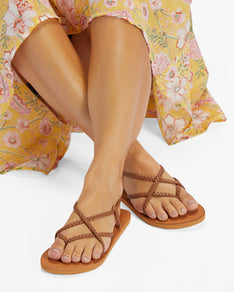
If you’re always on the move, sandals with adjustable straps are a great choice to create a comfortable, no-slip fit. Slide sandals with buckles or strappy styles with hook-and-loop closures are some of our favorites.
Adequate Arch Support and Cushioning

As we’ve mentioned, sandals with cushioned soles and built-in arch support are highly recommended for people with beyond-average arch types (as well as anyone who’s on their feet a lot). If you’re looking for even more support, arch inserts are an easy way to get the comfort you’re after.
Breathable and Flexible Materials
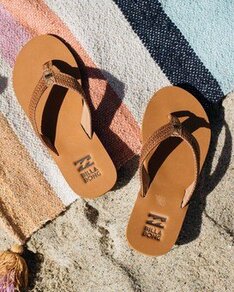
Sweat can cause friction between your feet and shoes. Look for sandals with fabric straps or soft rubber construction that will move with you and allow your feet to breathe.
Common Fit Issues and Solutions
Toe Overhang
If your toes are hanging over the tops of your sandals, it’s a sign that they are either too small or too narrow. Try a larger size or style that has a wider and deeper toe box to accommodate a broader foot.
Heel Slipping
Heel slippage happens when your heel pops out of your sandal as you walk. Your sandal may be too big or the wrong style for your foot. If possible, tighten the straps for a more secure fit, and if sizing down doesn’t help, try using adhesive heel grips for better traction.
Arch Pain
If you’re wearing sandals with adequate arch support, you’ve tried using cushioned inserts, and are still experiencing issues, double-check your sizing. Sandals that are too small or too large could be the culprit. After a long day of walking around, treat your feet to a good stretch and an ice bath to ease your muscles.
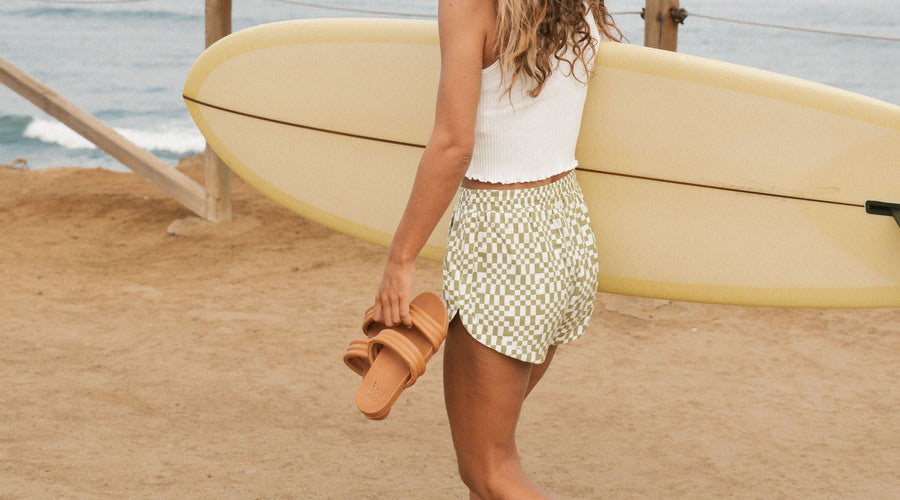
Toe Rubbing
Irritation can happen when your toes rub together or rub against the side of your sandal. The sandal may be too narrow for your foot or is sometimes just part of “breaking in” your new sandals. For an easy fix, wrap athletic tape around your toes where you are experiencing rubbing or try toe separators.
Blisters and Hotspots
Continuous rubbing against the skin can cause a hotspot, aka an area of warmth and reddened skin, or even blisters. Use antibiotic cream and cover the blister with a bandage or athletic tape. Let the area heal before taking your shoes on short walks to help break them in.
The size and shape of your foot – including width, toe structure, and arch type – combined with the many different styles and materials of summer footwear, all play a factor in keeping your feet comfortable on your next adventure.














